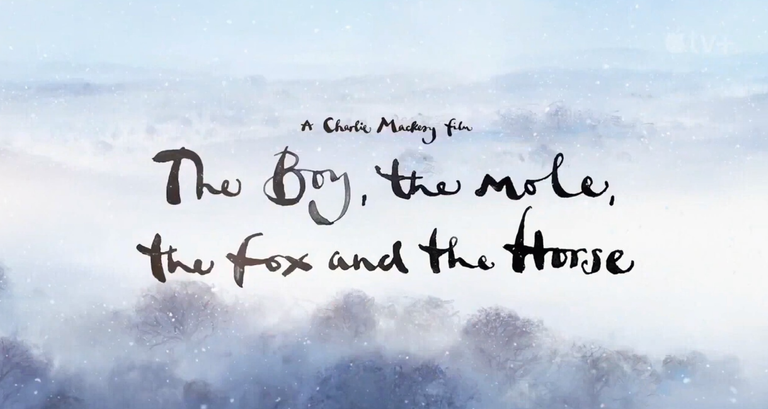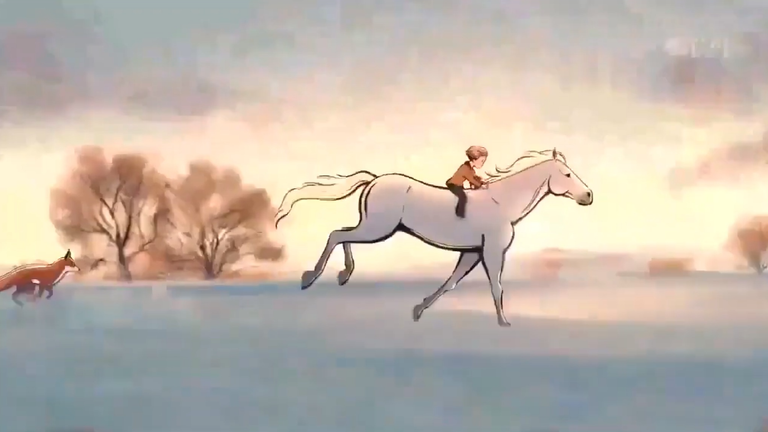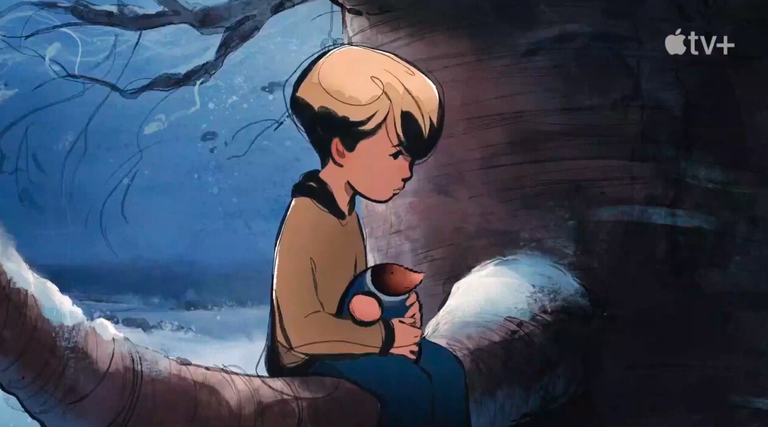[FR - ENG] L'Enfant, la Taupe, le Renard et le Cheval \ The Boy, the Mole, the Fox and the Horse

[ENG] The Boy, the Mole, the Fox and the Horse
Those who love or study animation know that animated shorts often hold great surprises, because they allow for great creative expression. Take the winners of the past two editions of the Oscars in the relevant category: If Anything Happens I Love You by Michael Govier and Will McCormack (you can find it on Netflix), a poignant reflection on the loss of a child in a situation as absurd as a school shooting, and The Windshield Wiper by Alberto Mielgo and Leo Sanchez, a peculiar love story that stands out above all for the amazing technique used, the same as that of a couple of episodes of Love, Death & Robots.
This year, the nominees in the Best Animated Short Film category of the Oscars were My Year of Dicks by Sara Gunnarsdóttir and Pamela Ribon, Ice Merchants by João Gonzalez, An Ostrich Told Me the World Is Fake and I Think I Believe It by Lachlan Pendragon, The Flying Saylor by Amanda Forbis and Wendy Tilby and The Boy, the Mole, the Fox and the Horse by Peter Baynton and Charlie Mackesy. The latter won, but the choice was not entirely convincing.

In fact, the awarding of the prize seems to have been the result of a strategy that characterised the entire award ceremony, which mostly exalted a good-natured, politically correct and condescending attitude, even more so than in other editions. The Boy, the Mole, the Fox and the Horse is based on an illustrated children's book by Charlie Mackesy himself, which is very famous not only for its excellent sales figures but also for the way in which it tells a series of moral and existential lessons through the medium of the fairy tale.
The same structure is maintained in the short film, which follows the journey of a lost child as he searches for home. On the way, he meets a series of animals with whom he will form a bond: a mole, a fox and a horse. The rhythm of the short film is deliberately suspended, hypnotic, and flanks a series of situations in which all the characters (human and non-human) learn something from each other. And the first thing they learn is definitely the importance of relying on loved ones. The problem is that these pills of wisdom, strung one after the other, burden the short film with too much allegorism.
Where, on the other hand, the work excels is on the technical front: the director has chosen to remain consistent with the aesthetic aspect of the book and, through classic 2D animation, has created a film whose visual strength is unimpeachable. Contributing to this result was Charlie Mackesy himself, who drew the storyboards. The technical part, on the other hand, was realised by a team of over 100 animators from all over the world, who worked with great creative freedom during the pandemic period. The main directive was to find a way to ink the characters that followed the particular lines of Mackesy's drawing. The colouring was also inspired by Mackesy's work, taking up that sense of watercolour and soft aesthetic approach typical of the author.

All this should come as no surprise, since the production force behind The Boy, the Mole, the Fox and the Horse was considerable: the BBC - which also provided its orchestra for the music -, J.J. Abrams' Bad Robots and even actor Woody Harrelson (True Detective) contributed to the making of this short.
Among the nominees, there was in any case better than The Boy, the Mole, the Fox and the Horse. In particular, The Flying Sailor stood out, for its simple yet evocative way of telling an extraordinary true story (that of a man who flew two kilometres following an explosion and survived), and An Ostrich Told Me the World Is Fake and I Think I Believe It, for its sarcastic and dramatic meta-narrative approach.
This is not to say that, in the panorama of animated productions, The Boy, the Mole, the Fox and the Horse does not stand out in terms of quality, especially in the choice of combining classical animation with minimal computer animation inserts, but always in an attempt to restore a feeling of handcrafted animation, consistent with the text and narrative subject matter. At its heart, in fact, this short film conceals all the infinite potential of animation.
The photos have been taken from individual images from the trailer, available for free on YouTube or other sites.
[FR] L'Enfant, la Taupe, le Renard et le Cheval
Ceux qui aiment ou étudient l'animation savent que les courts métrages d'animation réservent souvent de grandes surprises, car ils permettent une grande expression créative. Prenons les lauréats des deux dernières éditions des Oscars dans la catégorie concernée : If Anything Happens I Love You de Michael Govier et Will McCormack (vous pouvez le trouver sur Netflix), une réflexion poignante sur la perte d'un enfant dans une situation aussi absurde qu'une fusillade dans une école, et The Windshield Wiper d'Alberto Mielgo et Leo Sanchez, une histoire d'amour singulière qui se distingue surtout par la technique étonnante utilisée, la même que celle de quelques épisodes de Love, Death & Robots.
Cette année, les nominés dans la catégorie Meilleur court métrage d'animation des Oscars étaient My Year of Dicks de Sara Gunnarsdóttir et Pamela Ribon, Ice Merchants de João Gonzalez, An Ostrich Told Me the World Is Fake and I Think I Believe It de Lachlan Pendragon, The Flying Saylor d'Amanda Forbis et Wendy Tilby et L'Enfant, la Taupe, le Renard et le Cheval de Peter Baynton et Charlie Mackesy. C'est ce dernier qui l'a emporté, mais le choix n'a pas été totalement convaincant.

En fait, l'attribution du prix semble avoir été le résultat d'une stratégie qui a caractérisé l'ensemble de la cérémonie de remise des prix, qui a surtout exalté une attitude bon enfant, politiquement correcte et condescendante, encore plus que dans les autres éditions. L'Enfant, la Taupe, le Renard et le Cheval est basé sur un livre pour enfants illustré par Charlie Mackesy lui-même, très célèbre non seulement pour ses excellents chiffres de vente, mais aussi pour la manière dont il raconte une série de leçons morales et existentielles par le biais de la fable.
La même structure est conservée dans le court métrage, qui suit le voyage d'un enfant perdu à la recherche de sa maison et qui rencontre en chemin une série d'animaux avec lesquels il va se lier : une taupe, un renard et un cheval. Le rythme du court métrage est délibérément suspendu, hypnotique, et accompagne une série de situations dans lesquelles tous les personnages (humains et non humains) apprennent quelque chose les uns des autres. Et la première chose qu'ils apprennent est sans aucun doute l'importance de se fier à ses proches. Le problème est que ces pilules de sagesse, enchaînées les unes après les autres, alourdissent le court métrage d'un allégorisme excessif.
Là où, en revanche, l'œuvre excelle, c'est sur le plan technique : le réalisateur a choisi de rester cohérent avec l'aspect esthétique du livre et, par le biais d'une animation classique en 2D, a créé un film dont la force visuelle est irréprochable. Charlie Mackesy lui-même, qui a dessiné les story-boards, a contribué à ce résultat. La partie technique, quant à elle, a été réalisée par une équipe de plus de 100 animateurs du monde entier, qui ont travaillé avec une grande liberté créative pendant la période de la pandémie. La principale directive était de trouver un moyen d'encrer les personnages en suivant les lignes particulières du dessin de Mackesy. La mise en couleur s'est également inspirée du travail de Mackesy, reprenant le sens de l'aquarelle et l'approche esthétique douce typique de l'auteur.

Tout cela n'est pas surprenant, car la force de production de L'Enfant, la Taupe, le Renard et le Cheval était considérable : la BBC - qui a également fourni son orchestre pour la musique -, les Bad Robots de J.J. Abrams et même l'acteur Woody Harrelson (True Detective) ont contribué à la réalisation de ce court métrage.
Parmi les nominés, il y avait en tout cas mieux que L'Enfant, la Taupe, le Renard et le Cheval. En particulier, The Flying Sailor s'est distingué par sa façon simple mais évocatrice de raconter une histoire vraie extraordinaire (celle d'un homme qui a volé sur deux kilomètres à la suite d'une explosion et a survécu), et An Ostrich Told Me the World Is Fake and I Think I Believe It, par son approche méta-narrative sarcastique et dramatique.
Cela ne veut pas dire que, dans le panorama des productions animées, L'Enfant, la Taupe, le Renard et le Cheval ne se distingue pas en termes de qualité, notamment dans le choix de combiner l'animation classique avec des inserts minimaux d'animation par ordinateur, mais toujours en essayant de restituer une sensation d'animation artisanale, cohérente avec le texte et le sujet narratif. Au fond, ce court métrage recèle tout le potentiel infini de l'animation.
Les photos ont été prises à partir d'images individuelle du trailer, disponibles gratuitement sur YouTube ou d'autres sites.

!LOL
lolztoken.com
Ten- tickles
Credit: reddit
@albator85, I sent you an $LOLZ on behalf of @itharagaian
(3/10)